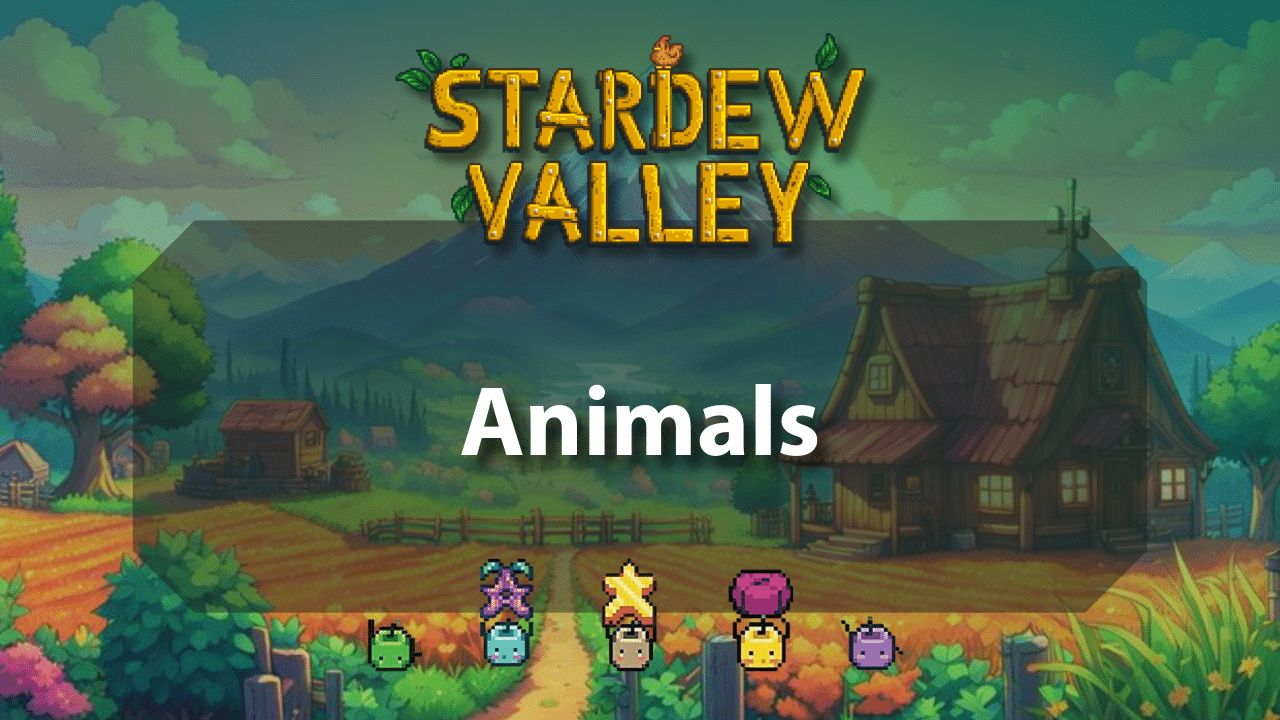
Introduction
Stardew Valley Animals are an essential part of farm life, providing valuable resources, companionship, and even improving efficiency through transportation. Raising animals properly can significantly enhance a farm’s profitability, offering a steady supply of goods that can be sold, processed, or used for crafting. Livestock such as cows and goats produce milk, which can be turned into cheese using a Cheese Press, while sheep provide wool that can be processed into cloth using a Loom.
Chickens, ducks, and rabbits offer a variety of useful resources, including eggs, duck feathers, and rabbit fur, which can be sold or used to craft artisan goods. Pigs are particularly valuable due to their ability to find truffles, which can be turned into truffle oil, a highly profitable artisan product. For those looking to add a unique touch to their farm, dinosaurs can be raised in a Big Coop, laying dinosaur eggs that can be incubated or sold for a high price.
Beyond their practical benefits, Stardew Valley Animals also contribute to the overall farming experience, adding an interactive and rewarding element to daily farm life. Horses greatly improve mobility, allowing players to travel faster and more efficiently around the valley, reducing the time spent walking between locations. Meanwhile, pets such as cats and dogs may not produce resources, but they play an important role in Grandpa’s evaluation, helping improve the farm’s overall score when fully bonded with. Keeping animals happy is key to maintaining productivity, which requires providing shelter, food, and regular interaction. Animals that are well-fed, protected from harsh weather, and frequently petted will produce higher-quality goods, increasing the farm’s income.
To maximize efficiency, upgrading barns and coops is essential, allowing more animals to be housed and unlocking automation features such as automatic feeders, which ensure livestock receive food daily without manual input. During the winter months, installing heaters inside barns and coops prevents animals from becoming unhappy, ensuring they continue producing resources despite the cold.
Silo storage is another important factor in managing livestock, as it allows players to store hay, which is used to feed animals when they cannot graze on grass. Proper management of Stardew Valley Animals ensures a steady supply of resources and increases overall farm profits, making them an indispensable part of the farming experience. Whether raising livestock for profit, companionship, or personal satisfaction, animals bring life to the farm and offer a more immersive and rewarding way to play the game.
Getting Started with Animals
Before acquiring animals in Stardew Valley, you must first construct the appropriate housing to ensure they have a safe and comfortable environment. Barns are required for larger animals, including cows, goats, sheep, pigs, and ostriches, while coops house smaller animals such as chickens, ducks, rabbits, and dinosaurs. Both barns and coops can be purchased from Robin at the Carpenter’s Shop, and each takes three days to complete once construction begins. Having the proper housing before purchasing animals is essential, as they cannot be kept on the farm without a suitable shelter. Well-maintained housing contributes to animal happiness, which directly affects their productivity and the quality of resources they provide.
Barns and coops come with multiple upgrade levels that increase their capacity and introduce new features. A standard barn can accommodate cows and goats, but upgrading to a Big Barn expands space and allows for sheep and pigs. The final upgrade, the Deluxe Barn, further increases the number of animals it can hold and introduces an automatic feeding system, eliminating the need for manual hay distribution.
Coops follow a similar upgrade path, with a standard coop housing chickens and ducks. Upgrading to a Big Coop allows for rabbits and dinosaurs, while the Deluxe Coop increases capacity and adds automatic feeding, making daily care much more convenient. These upgrades play a significant role in farm efficiency, especially for large-scale animal husbandry, as they reduce the amount of time spent manually feeding animals and allow for greater resource production.
Once the necessary buildings are constructed, animals can be purchased from Marnie’s Ranch. Available livestock includes cows, goats, sheep, pigs, chickens, ducks, and rabbits, while ostriches and dinosaurs require special eggs to be incubated before they can be raised. When purchasing an animal, you must select a barn or coop for it to live in, and baby animals must mature before they start producing resources.
Cows and goats provide milk, which can be processed into cheese, while sheep produce wool that can be turned into cloth using a loom. Pigs do not generate resources directly but will dig up valuable truffles when allowed to roam outside. Chickens lay eggs, ducks provide both eggs and feathers, and rabbits occasionally produce rabbit’s feet or wool. Dinosaurs lay dinosaur eggs, which can be sold or used to hatch more dinosaurs, and ostriches lay large eggs that can be processed for additional profit.
Ensuring animals are well cared for is key to maintaining a productive farm. Feeding them daily with hay or fresh grass, petting them to increase friendship, and keeping them sheltered from bad weather all contribute to their overall happiness. In winter, placing a heater inside a barn or coop prevents animals from becoming unhappy due to the cold. Allowing animals to graze outside on sunny days can improve their mood, and upgrading buildings provides more space and automation, making farm management easier. Proper housing, regular care, and strategic upgrades ensure that Stardew Valley animals remain happy and productive, making them an essential part of a successful and profitable farm.
Types of Animals
Coop animals in Stardew Valley provide valuable resources and require proper care to maximize their productivity. Chickens lay eggs daily, with happier chickens producing larger, more valuable eggs. They come in white, brown, or blue varieties, with blue chickens available after reaching an eight-heart friendship with Shane. Void Chickens lay Void Eggs and can be obtained through a random event, purchased from Krobus, or gifted by Shane.
Golden Chickens, which lay Golden Eggs, become available after achieving Perfection. Ducks lay Duck Eggs or drop Duck Feathers every other day, with higher happiness increasing the chance of obtaining a feather. Rabbits produce wool every four days, and happier rabbits have a greater chance of dropping a Rabbit’s Foot. Dinosaurs lay Dinosaur Eggs every seven days, but they must first be hatched from an incubated Dinosaur Egg.
Barn animals provide a range of resources that can be processed into artisan goods. Cows produce milk daily, with higher friendship increasing the likelihood of obtaining Large Milk, which can be turned into cheese using a Cheese Press. Goats produce milk every other day, which can also be processed into cheese. Sheep grow their wool coats over time and can be sheared when ready, with their wool being used for crafting or sold for profit.
Pigs are valuable for locating Truffles when let outside, which can be used to produce Truffle Oil, one of the most profitable artisan goods. However, pigs do not find truffles during winter, as they require outdoor access to uncover them. Ostriches lay Ostrich Eggs every seven days, which can be sold or processed into multiple servings of mayonnaise.
Other animals in Stardew Valley serve different purposes beyond resource production. Pets, which can be either a cat or a dog, are adopted early in the game. Building a strong bond with a pet by interacting with them daily can contribute to Grandpa’s farm evaluation. Additional pets can be adopted by purchasing pet licenses from Marnie’s Ranch. Horses significantly improve mobility around the farm and the valley, increasing movement speed by 30%.
They are obtained by constructing a stable from the Carpenter’s Shop, which allows for faster travel and more efficient time management. Caring for all animals properly, ensuring they are well-fed, happy, and sheltered when needed, helps maximize their productivity and benefits, making them an essential part of a successful farm.
Animal Care
Proper care is essential for maintaining animal happiness and productivity in Stardew Valley, as happier animals produce higher-quality goods that increase farm profits. Feeding them daily is crucial, and they can either graze on fresh grass when outdoors or eat hay when kept inside. Allowing animals to graze outside on sunny days boosts their mood, but during winter or rainy days, they must rely on hay stored in silos. Planning ahead by harvesting and storing enough hay before winter ensures animals remain well-fed when grass is unavailable. If an animal goes unfed, its happiness decreases, leading to lower-quality products and a temporary halt in production. Ensuring a consistent food supply is key to maintaining their well-being.
Petting animals daily also plays an important role in increasing their happiness and friendship levels. Higher friendship results in better-quality goods, such as Large Milk from cows or Large Eggs from chickens. In addition to petting, actions like milking cows and goats, shearing sheep, and letting animals graze contribute to friendship growth. Conversely, neglecting them, leaving them outside overnight, or failing to feed them lowers their friendship and productivity. The friendship level of each animal can be checked in the farm menu, allowing farmers to monitor progress and ensure their animals remain content.
Letting animals outside on sunny days not only allows them to graze but also improves their overall mood. However, it is important to close barn and coop doors at night to prevent animals from becoming unhappy the next day. While there are no predators in Stardew Valley that can harm livestock, animals left outside overnight will become grumpy, leading to decreased production. Installing an auto-petter in barns and coops, which can be purchased from JojaMart or found in Skull Cavern, provides an alternative way to maintain friendship without manually petting animals each day.
Managing animals properly also involves upgrading barns and coops to improve efficiency. Upgrading to a Deluxe Barn or Deluxe Coop unlocks automatic feeding, ensuring that hay is distributed automatically from silos, saving time and effort. Heaters placed inside barns and coops during winter prevent animals from becoming unhappy due to the cold, helping them maintain their productivity year-round. By consistently feeding, petting, and managing outdoor time effectively, farmers can maximize their animals’ happiness and productivity, making them a crucial and rewarding part of farm life.
Maximizing Profit
To maximize profit from animals in Stardew Valley, maintaining a high mood and friendship level is essential, as they directly impact the quality and value of the products animals produce. Animals with a mood of 150 or higher have a greater chance of producing higher-quality goods, and those with maximum friendship are more likely to generate deluxe or large products, such as Large Milk, Large Goat Milk, and Large Eggs.
Ensuring animals are well-fed every day is the most important factor in keeping their mood high. They can either eat fresh grass outside, which boosts happiness, or consume hay indoors when grazing is not possible. Storing enough hay in silos before winter is critical, as animals cannot graze during snowy weather. Failing to feed an animal for a day decreases its mood, which can result in lower-quality products or even a temporary halt in production.
Petting animals daily also plays a crucial role in increasing both mood and friendship. Each interaction raises an animal’s friendship level, making them more productive over time. Friendship is represented by hearts in the farm menu, with a maximum of five hearts per animal. In addition to petting, actions like milking cows and goats, shearing sheep, and allowing animals to graze outside further increase friendship. However, ignoring them, forgetting to feed them, or leaving them outside overnight can decrease friendship, leading to reduced product quality and quantity. Keeping barn and coop doors closed at night prevents animals from becoming unhappy, as they prefer the security of being inside after dark.
During winter, placing a heater inside a barn or coop helps maintain an animal’s happiness. Although animals will still require hay for food, the heater ensures they remain comfortable despite the cold. Upgrading barns and coops to the Deluxe level unlocks an automatic feeding system that distributes hay from the silo, reducing the daily workload and preventing animals from going hungry if the farmer forgets to feed them manually. Using an auto-petter, which can be obtained from JojaMart or Skull Cavern, provides a way to maintain friendship without the need for daily petting, allowing for more efficient farm management.
Processing animal products into artisan goods is another key strategy for increasing profit. Base products like milk, wool, and truffles sell for a decent price, but their processed versions are significantly more valuable. Milk can be turned into cheese using a Cheese Press, and Large Milk produces Gold or Iridium-quality cheese, which sells for a much higher price.
Goat Milk can be processed into Goat Cheese, which follows the same quality scaling. Wool from sheep and rabbits can be spun into cloth using a Loom, increasing its value. Pigs, one of the most profitable animals in the game, produce truffles when left outside, and processing truffles into Truffle Oil with an Oil Maker greatly increases their worth. While truffles can be sold as-is for a high price, turning them into Truffle Oil is a better long-term strategy for maximizing profit.
By consistently maintaining high animal happiness, increasing friendship levels through regular interaction, and processing animal products into artisan goods, farmers can ensure they get the highest possible income from their livestock. Efficient management of barns and coops, proper feeding strategies, and strategic product processing all contribute to making animals one of the most rewarding and profitable aspects of Stardew Valley farming.
Other Considerations
An animal’s mood in Stardew Valley plays a crucial role in determining the quality and type of products they produce. A high mood increases the chances of obtaining high-quality goods, such as Large Milk from cows, Large Eggs from chickens, and premium items like Duck Feathers and Rabbit’s Feet. The best way to boost an animal’s mood is by allowing them to graze on fresh grass outside, which instantly raises their mood to 255, the maximum possible value.
Consistently feeding animals, petting them daily, and ensuring they have a safe and comfortable environment all contribute to maintaining a high mood. Neglecting these aspects can cause animals to become unhappy, resulting in lower-quality products or even a temporary halt in production.
Ensuring animals are safe is another key aspect of livestock management. Barn and coop animals should always be brought inside before nightfall, as leaving them outside overnight negatively affects their mood the following day.
While coop animals are never at risk, barn animals have the potential to give birth if the pregnancy option is enabled. Cows, goats, and sheep may become pregnant randomly if there is space in the barn, leading to the birth of a new animal after several days.
This allows players to expand their livestock without purchasing new animals from Marnie’s Ranch. However, pigs do not give birth, meaning they must always be purchased. Managing barn space efficiently ensures that newly born animals do not exceed the barn’s capacity, preventing overcrowding and maintaining optimal farm organization.
Selling animals is another important part of livestock management. Animals can be sold at any time by right-clicking on them after petting them, allowing farmers to make space for more profitable choices or streamline their farm’s operations. The selling price of an animal is determined by its base cost and friendship level, meaning animals with higher friendship are worth more when sold. This provides an opportunity to optimize farm profits by raising animals to high friendship levels before selling them. However, it is important to consider long-term farm goals when deciding which animals to keep or sell, as some provide better returns through their products rather than direct sales.
Proper care and management of animals significantly contribute to a farm’s overall success in Stardew Valley. Maintaining high mood levels, ensuring animals are well-fed, keeping them safe from potential threats, and processing their products into artisan goods all help maximize profitability. Upgrading barns and coops to include automatic feeding systems reduces daily chores, while installing heaters ensures animals remain comfortable in the winter, preventing mood drops. Farmers who prioritize efficient livestock management will enjoy a steady and reliable source of income from their animals, creating a thriving and productive farm that continues to grow and prosper over time.













